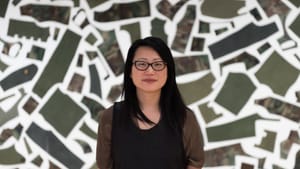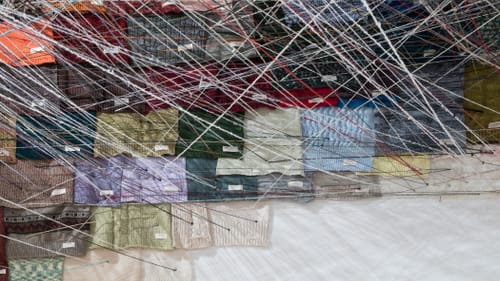Stay in the Loop
BSR publishes on a weekly schedule, with an email newsletter every Wednesday and Thursday morning. There’s no paywall, and subscribing is always free.
Belonging and belongings
Philadelphia Museum of Art presents 'Jean Shin: Collections'

Jean Shin: Collections is a clutterbug’s dream. Shin, a contemporary Asian-American artist, creates site-specific installations, sculpture, and video from the stuff that landfills are made of. This small exhibition of her large compositions is on view at the Philadelphia Museum of Art.
Patient and meticulous, Shin conscripts materials from the public and breaks them down like Marine recruits at Parris Island. For Worn Soles (2001), she disassembled dozens of pairs of old shoes. Turning the soles bottoms-up, she positioned them in a mesmerizing swirl on the floor of the Perelman Building’s Joan Spain Gallery.
Soleful works
Imagine standing below ground as an unseen crowd converges. Their soles are the scuffed gray of a down economy, with more than a few holes. Kitten heels provide triangular divots of color. More than half the shoes are women’s. Brogues and wingtips stand to one side as if to let the ladies pass. There are no foot-cradling athletic soles here: you’d hear this crowd coming.
Hide (2004), in which Shin used the leftover uppers to reconstitute an abstract herd, is nearby. Sewing the leather of each pair together, Shin created loops and combined them into similarly colored hangings of red, brown, black, and white.
Incorporating owners essence
Things kept but no longer used are Shin’s clay. Middle-school trophies, old lottery tickets, and those ubiquitous amber pill bottles become art that prompts questions about what we use, what we keep, and where it all goes when we finally clean house. Rather than shunning our acquisitive tendencies, Shin seeks them out, believing possession to confer a sense of the owner onto the object and, by extension, into her art.
Though Shin unavoidably addresses how much stuff people have, the artist, born in Seoul, South Korea, has more than environmental guilt in mind. She is creating community among those providing material, the finished work, and herself.
Unraveling (2006-18) celebrates Asian-American artists in communities where the work is exhibited. It consists of swatches from local artists’ sweaters, each bearing the donor’s name. The woven squares hang high on facing walls in an unfinished patchwork. From the swatches, Shin loosens threads and connects them to other sweaters, symbolizing relationships between artists. In this way, she creates a sheltering canopy across the enclosure.

E pluribus art
If Shin wanted only to scold wastefulness, she could dumpster dive for raw material. Instead, she unifies, making collaborators of those turning over their accumulated detritus, creating one work from the contributions of many.
Shin, an adjunct professor of fine art at Brooklyn’s Pratt Institute, says working this way forces her to interact with the wider world. When military uniforms were on her wish list, for example, she reached out to former service members and produced Armed (2005-09), a puzzle of sleeves, collars, and jacket panels in blue, green, and brown camouflage.
Unique among the items on view is a video, Penumbra (2003), a work in which the wind was Shin’s collaborator. She collected blown-out umbrellas from New York streets, deboned them, and sewed the fabric into a perforated canopy. Then she suspended it from trees in a Long Island City, New York, park to catch the breeze.
Look and listen as the wind whooshes softly, billowing the piece, which looks like a blanket of flowers. Unseen wind chimes ring gently. The video lasts five minutes, but if the gallery is quiet and you watch uninterrupted, the calm it induces stays with you.
In process and product, Shin reveals parallels between belongings and belonging. New things are novel, and we’re enthusiastic. They become scuffed, frayed, mundane, and we lose interest. We find them in a corner and almost toss them until we remember why they were important. We hold on, thinking we might use them again — maybe for something artistic.
What, When, Where
Jean Shin: Collections. Through July 15, 2018, at the Philadelphia Museum of Art's Perelman Building, 2525 Pennsylvania Avenue, Philadelphia. (215) 763-8100 or philamuseum.org.
Sign up for our newsletter
All of the week's new articles, all in one place. Sign up for the free weekly BSR newsletters, and don't miss a conversation.
